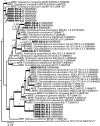Minimal genomes of mycoplasma-related endobacteria are plastic and contain host-derived genes for sustained life within Glomeromycota
- PMID: 25964324
- PMCID: PMC4485128
- DOI: 10.1073/pnas.1501676112
Minimal genomes of mycoplasma-related endobacteria are plastic and contain host-derived genes for sustained life within Glomeromycota
Abstract
Arbuscular mycorrhizal fungi (AMF, Glomeromycota) colonize roots of the majority of terrestrial plants. They provide essential minerals to their plant hosts and receive photosynthates in return. All major lineages of AMF harbor endobacteria classified as Mollicutes, and known as mycoplasma-related endobacteria (MRE). Except for their substantial intrahost genetic diversity and ability to transmit vertically, virtually nothing is known about the life history of these endobacteria. To understand MRE biology, we sequenced metagenomes of three MRE populations, each associated with divergent AMF hosts. We found that each AMF species harbored a genetically distinct group of MRE. Despite vertical transmission, all MRE populations showed extensive chromosomal rearrangements, which we attributed to genetic recombination, activity of mobile elements, and a history of plectroviral invasion. The MRE genomes are characterized by a highly reduced gene content, indicating metabolic dependence on the fungal host, with the mechanism of energy production remaining unclear. Several MRE genes encode proteins with domains involved in protein-protein interactions with eukaryotic hosts. In addition, the MRE genomes harbor genes horizontally acquired from AMF. Some of these genes encode small ubiquitin-like modifier (SUMO) proteases specific to the SUMOylation systems of eukaryotes, which MRE likely use to manipulate their fungal host. The extent of MRE genome plasticity and reduction, along with the large number of horizontally acquired host genes, suggests a high degree of adaptation to the fungal host. These features, together with the ubiquity of the MRE-Glomeromycota associations, emphasize the significance of MRE in the biology of Glomeromycota.
Keywords: genome contraction; genome plasticity; horizontal gene transfer; vertical transmission.
Conflict of interest statement
The authors declare no conflict of interest.
Figures




Comment in
-
Scrambled and not-so-tiny genomes of fungal endosymbionts.Proc Natl Acad Sci U S A. 2015 Jun 23;112(25):7622-3. doi: 10.1073/pnas.1508360112. Epub 2015 Jun 8. Proc Natl Acad Sci U S A. 2015. PMID: 26056315 Free PMC article. No abstract available.
References
-
- Smith SE, Read DJ. Mycorrhizal Symbiosis. 3rd Ed Academic; New York: 2008.
-
- Gianinazzi S, et al. Agroecology: The key role of arbuscular mycorrhizas in ecosystem services. Mycorrhiza. 2010;20(8):519–530. - PubMed
-
- Mosse B. Honey-coloured, sessile Endogone spores: II. Changes in fine structure during spore development. Arch Microbiol. 1970;74(2):129–145.
-
- Naumann M, Schüssler A, Bonfante P. The obligate endobacteria of arbuscular mycorrhizal fungi are ancient heritable components related to the Mollicutes. ISME J. 2010;4(7):862–871. - PubMed
-
- Sirand-Pugnet P, Citti C, Barré A, Blanchard A. Evolution of mollicutes: Down a bumpy road with twists and turns. Res Microbiol. 2007;158(10):754–766. - PubMed
Publication types
MeSH terms
Associated data
- Actions
- Actions
- Actions
LinkOut - more resources
Full Text Sources
Other Literature Sources
Molecular Biology Databases

